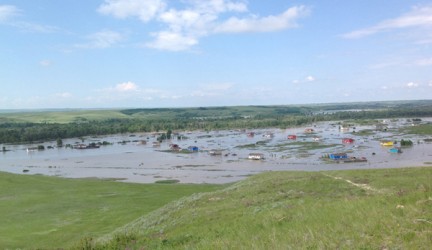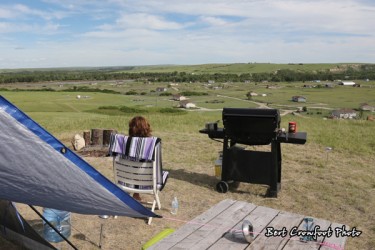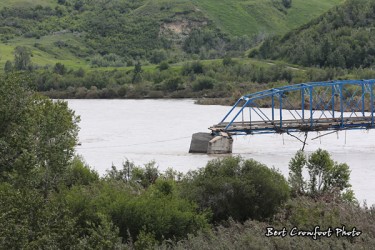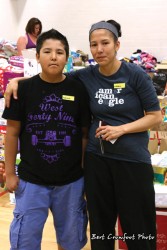Article Origin
Volume
Issue
Year
Three weeks after states of emergency were declared on the Siksika First Nation and Stoney Nakoda Nations, impacted community members have received $4.5 million in help from the provincial government. Flooding caused by torrential downpours and overflowing river banks left communities devastated.
With 25 local governments, including Tsuu T’ina First Nation and the cities of Calgary and Medicine Hat, declaring states of emergency on June 20, Premier Alison Redford established a $1-billion fund. The fund included the distribution of pre-loaded debit cards of $1,250 per adult and $500 per child for those out-of-home for more than one week. Registration centres were set up on the Siksika First Nation and the Stoney Nakoda Nations.
As of July 10, 1,967 payments ($3.4 million) were made to Stoney Nakoda Nations members and 633 payments ($1.4 million) were made to Siksika members. Those figures are based on a provincial average per household of $1,750 and are not complete.
“Alternative arrangements are being made for people who are eligible to receive a card, but have not been able to do so yet. We expect details to be available in the near future,” said Susan Williams with the Provincial Operations Centre.
Redford declared the flooding the worst in Alberta’s history and established the Southern Alberta Ministerial Task Force, which includes Aboriginal Relations Minister Robin Campbell, and appointed three associate ministers to do work on the ground.
“My task is to rebuild the First Nations,” said Campbell, who toured flood sites, both with and without Redford, and met with chiefs and councils, and Assembly of First Nations National Chief Shawn Atleo.
Atleo was in Calgary and Lethbridge when the flooding began. He returned June 26 and June 27 to meet with impacted leadership, as well as provincial and federal politicians.
Alberta Emergency Management Agency field officers were in Siksika and Morley to provide assistance and advice.
Boil water advisories were put in place, roads were washed out and bridges needed to be assessed for safety.
The Siksika First Nation remained in a local state of emergency until July 11.
“We’re still thinking of the health and safety of all our people.
That comes first,” said Chief Fred Rabbit Carrier. More than 1,000 Siksika Nation members, one-quarter of the on-reserve population, were still out of their homes.
Of the more than 200 homes evacuated on the Siksika First Nation, 170 experienced some flood damage and 140 will be uninhabitable for some time, perhaps permanently. Temporary dwellings, in the forms of mobile homes not used during the Slave Lake fire two years ago, and ATCO trailers will be brought in within three weeks. Larger families will be placed in the mobile homes, which will be spread throughout the reserve, while the ATCO trailers will form camps in five designated locations.
Until the temporary housing arrives, evacuees remain in the emergency centre established at the Deerfoot Sportsplex, with friends and families, or are camping.
In all, close to 2,000 First Nations members were evacuated. Along with the 1,000 from Siksika First Nation, close to 700 members of Stoney Nakoda Nations in Eden Valley, Bighorn and Morley were forced to flee, 50 from Tsuu T’ina, 40 from Kainai and a handful from the Piikani.
The quick response from the province providing First Nations with the same services as the affected municipalities has been appreciated, said Rabbit Carrier.
A number of meetings have taken place with the federal government and Aboriginal Affairs and Northern Development Canada Minister Bernard Valcourt, who toured the impacted First Nations shortly after states of emergency were declared. While no solid commitments have been provided, Rabbit Carrier said he expects the federal government “will be there” with support.
Also quick to respond were local municipalities, volunteer organizations, and other First Nations.
“We’re humbled by all the help we’re getting,” said Rabbit Carrier.
As river waters rose, neighbouring municipalities joined forces with First Nations to sandbag, and move in flood pumps and heavy equipment.
While people were still reeling from the devastation, non-perishable foods, clothing, blankets, personal hygiene items and monetary goods started arriving.
“First Nations from across Canada, from coast to coast to coast. We had people from the Northwest Territories all the way to northern Quebec. They were all here and we’re still getting calls,” said Rabbit Carrier.
Religious groups, such as the Mormons and the Mennonites; charitable organizations such as Red Cross and Bridges Social Development; and local industry, such as Shell Canada and Dow AgroSciences Canada Inc., have provided help both in terms of labour and finance.
Rabbit Carrier said Siksika First Nation has hired Meyers Norris Penny to ensure accountability in the use of financial donations.
Mental health workers are also on the ground in the First Nations.
“We’re coping with it, but it’s mixed emotions from person to person,” said Rabbit Carrier, who was among those evacuated, but his home, situated on higher ground, was not damaged. His nearest neighbour, however, suffered extensive damage.
“I’ve never experienced something of this capacity before,” he said. “As a leader you’ve got to put your emotions aside and lead.”
- 4598 views




